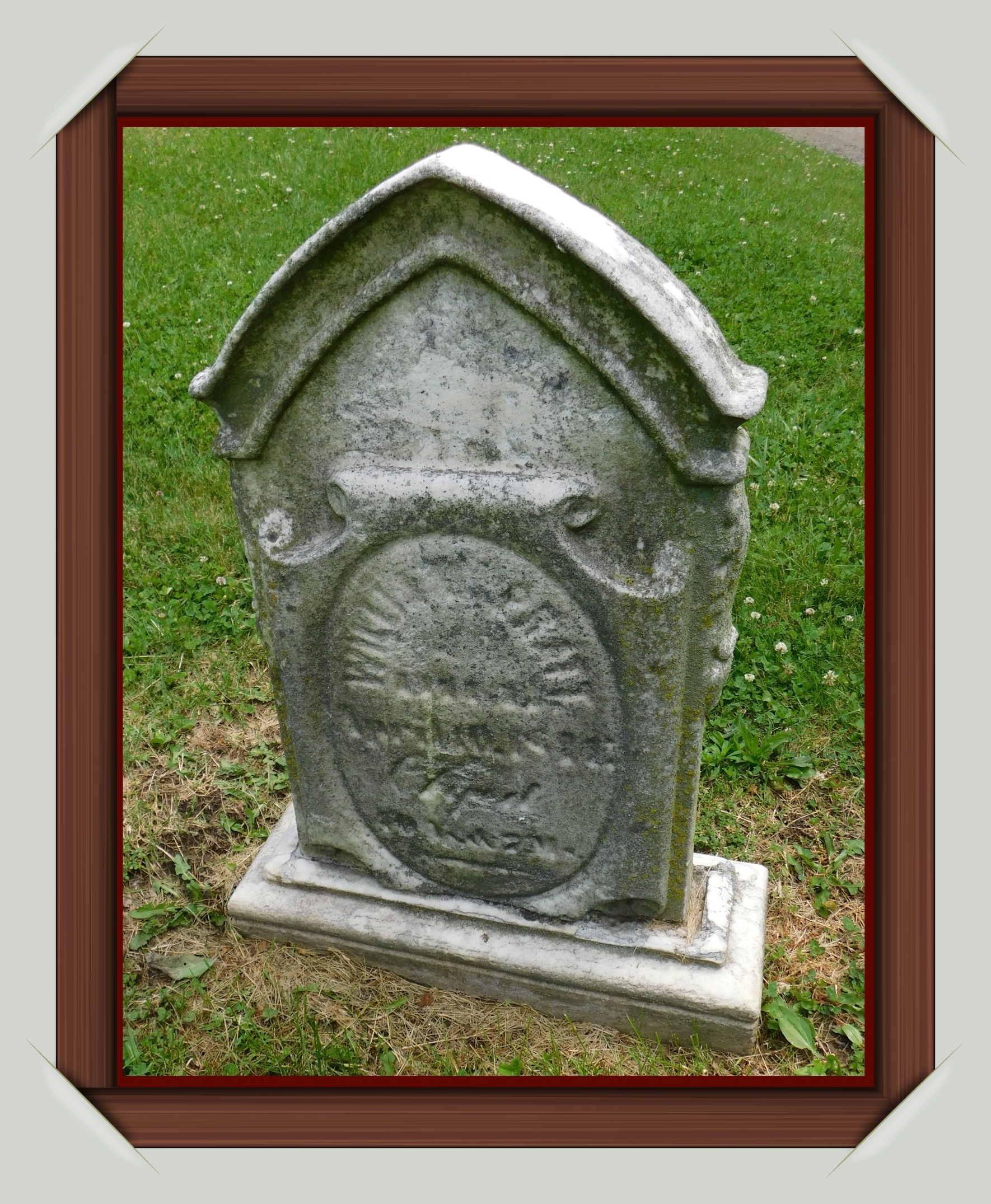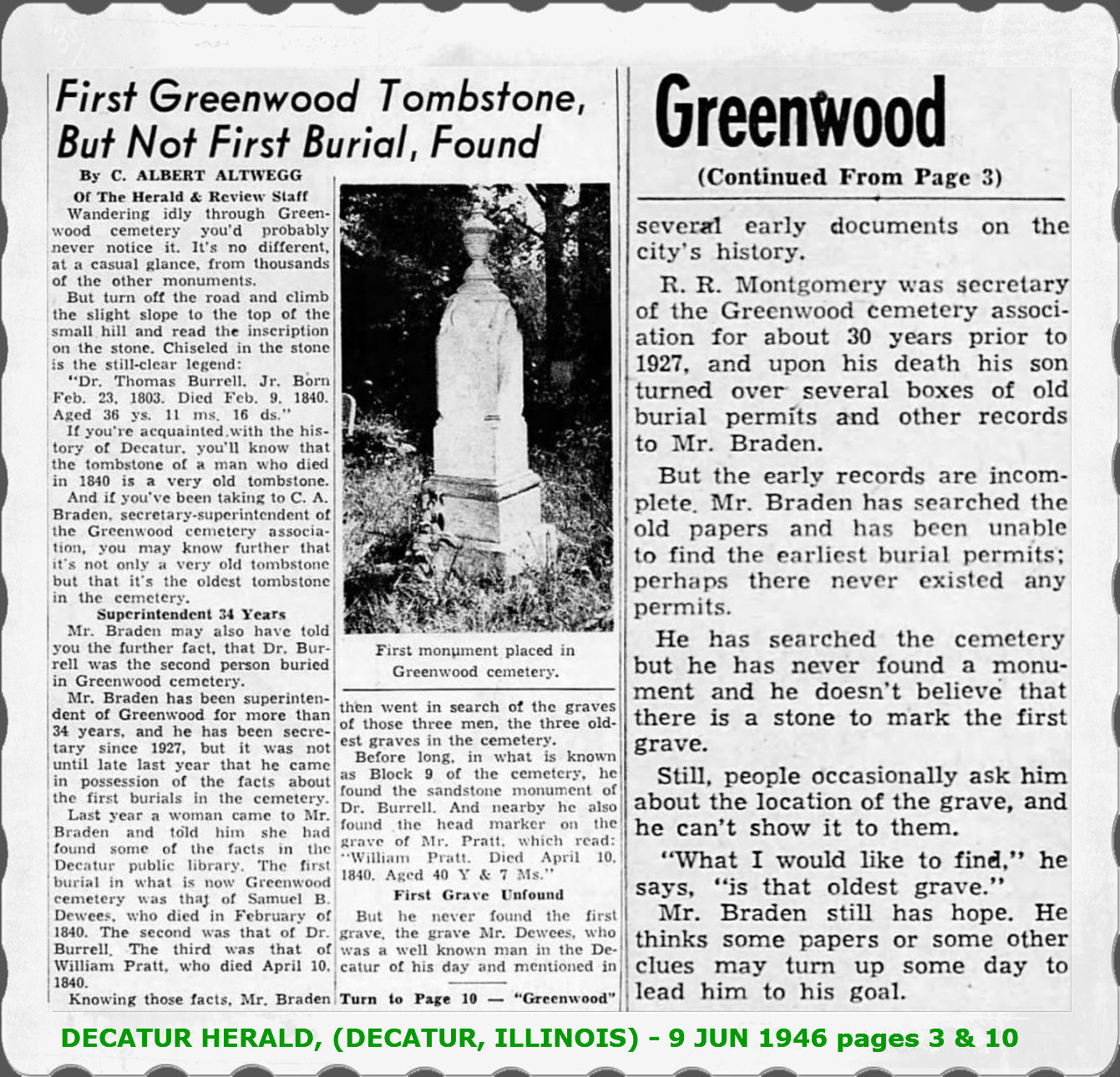EARLY RECORDS
 | David Lee Allen had a small cemetery which was open to public burials. It is unknown when he opened the cemetery. Beginning around 1840, a few records appeared that chronicled burials in David Allen's cemetery - later becoming Greenwood Cemetery. The oldest marked grave in Greenwood belonged to a man named "William Pratt", who had died in 1811. Unfortunately, this was a misprint and he actually died April 10, 1840 and was the third "recorded" burial in the cemetery. The first recorded burial was of a man named "Samuel B. DeWees" and the second was that of a "Dr. Burrell", both of whom also died in 1840. Again, it should be noted that these were burials that were actually recorded. Further research has found that Samuel B. DeWees, who died in 1840, has as stone in Spangler Cemetery in Decatur. He is buried with Joseph, (d.1852) and William, (d.1872) who are probably his brothers. Maybe his body was removed from Greenwood to Spangler to be with family or possibly they just made a stone there and he is still in Greenwood. There will always be mysteries like this. |
 On March 3, 1857, the newly established Greenwood Cemetery Association was organized and the cemetery was incorporated into the city of Decatur. One of the main stockholders in the association was a prominent local businessman named Henry Prather. He would ultimately be responsible for the design of the main cemetery gates and for much of the design and layout of the cemetery itself. Things were still fairly primitive in those days though and the association had little outlook for the future of the cemetery. Burial plots were sold for $10 each in those days and the idea that an entire work force would someday be needed to tend the grounds never occurred to them. That was a problem that would come back to haunt Greenwood in the years ahead. By 1900, Greenwood Cemetery was widely accepted as the most fashionable place in the city to be buried. It was the place where even the most common could spend eternity next to the elite of Decatur society. In those days, Decatur's other primary cemeteries had not yet come into being. Graceland Cemetery -1919, Fairlawn -1913 and Calvary Cemetery-1871, Catholic faith. The cemetery was in pristine condition and was managed with a crew of about 8 men. Greenwood Cemetery had become known as the "Beautiful City of the Dead" ---- but it wouldn't hang onto that description for long. By the middle 1920's the cemetery had no money. In 1926, they had reduced the crew of the cemetery to just two men, who admittedly were unable to give the grounds the attention needed. Around this same time, many cemeteries along the east coast had started a program called "Perpetual Care". This meant that burial plots could be sold at a much higher price with the stipulation that they would always be cared for. Nothing like this had been available when Greenwood was started, but it was possible that the new influx of cash could be the answer to the current money problems. Unfortunately though, it was not the answer to everything, because while the new income did care for the recent Perpetual Care plots, it did not allow any excess money to care for the rest of the graveyard. The grounds crew had to be assigned to care for the areas that had been paid for and the rest of the burial ground began to suffer because of it. It wasn't long before a large portion of the cemetery began to resemble a forgotten boneyard with overgrown grass, rampant weeds and brush, fallen branches and tipped and broken gravestones. The Perpetual Care fund continued to grow. The additional income allowed the caretakers to mow the entire cemetery a total of four times that year, which had not been accomplished in some time. By 1932, the superintendents were receiving commendations for their improvements to the cemetery. This was a brief period of revival and progress. By 1938, the cemetery was in dire straits again. The size of the crew was again reduced and during that summer, the entire cemetery was mowed only one time. The 1940's are a lost portion of Greenwood Cemetery history. As 1950 rolled around, the place once called the "Beautiful City of the Dead" was no more. Greenwood Cemetery was in ruins. Water, time and vandals had wreaked havoc on Greenwood's tombstones and markers. Years of rain, harsh weather and wind had caused many of the stones to sag at odd angles and a lack of care caused many of them to become lost. Others lay broken and damaged beyond repair, having given up the fight against the elements. On March 3, 1857, the newly established Greenwood Cemetery Association was organized and the cemetery was incorporated into the city of Decatur. One of the main stockholders in the association was a prominent local businessman named Henry Prather. He would ultimately be responsible for the design of the main cemetery gates and for much of the design and layout of the cemetery itself. Things were still fairly primitive in those days though and the association had little outlook for the future of the cemetery. Burial plots were sold for $10 each in those days and the idea that an entire work force would someday be needed to tend the grounds never occurred to them. That was a problem that would come back to haunt Greenwood in the years ahead. By 1900, Greenwood Cemetery was widely accepted as the most fashionable place in the city to be buried. It was the place where even the most common could spend eternity next to the elite of Decatur society. In those days, Decatur's other primary cemeteries had not yet come into being. Graceland Cemetery -1919, Fairlawn -1913 and Calvary Cemetery-1871, Catholic faith. The cemetery was in pristine condition and was managed with a crew of about 8 men. Greenwood Cemetery had become known as the "Beautiful City of the Dead" ---- but it wouldn't hang onto that description for long. By the middle 1920's the cemetery had no money. In 1926, they had reduced the crew of the cemetery to just two men, who admittedly were unable to give the grounds the attention needed. Around this same time, many cemeteries along the east coast had started a program called "Perpetual Care". This meant that burial plots could be sold at a much higher price with the stipulation that they would always be cared for. Nothing like this had been available when Greenwood was started, but it was possible that the new influx of cash could be the answer to the current money problems. Unfortunately though, it was not the answer to everything, because while the new income did care for the recent Perpetual Care plots, it did not allow any excess money to care for the rest of the graveyard. The grounds crew had to be assigned to care for the areas that had been paid for and the rest of the burial ground began to suffer because of it. It wasn't long before a large portion of the cemetery began to resemble a forgotten boneyard with overgrown grass, rampant weeds and brush, fallen branches and tipped and broken gravestones. The Perpetual Care fund continued to grow. The additional income allowed the caretakers to mow the entire cemetery a total of four times that year, which had not been accomplished in some time. By 1932, the superintendents were receiving commendations for their improvements to the cemetery. This was a brief period of revival and progress. By 1938, the cemetery was in dire straits again. The size of the crew was again reduced and during that summer, the entire cemetery was mowed only one time. The 1940's are a lost portion of Greenwood Cemetery history. As 1950 rolled around, the place once called the "Beautiful City of the Dead" was no more. Greenwood Cemetery was in ruins. Water, time and vandals had wreaked havoc on Greenwood's tombstones and markers. Years of rain, harsh weather and wind had caused many of the stones to sag at odd angles and a lack of care caused many of them to become lost. Others lay broken and damaged beyond repair, having given up the fight against the elements.
|
NOTE: THERE ARE 20 to 30 STONES THAT ARE OLDER
THAN 1840 LOCATED IN GREENWOOD CEMETERY.
THESE ARE PEOPLE WHO WERE BURIED IN OTHER
LOCATIONS AND LATER RELOCATED TO GREENWOOD.
THERE ARE MANY OTHERS THAT DO NOT HAVE STONES.
|
|
|